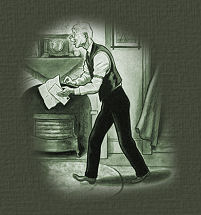
BUTLER ENTERPRISE
Enterprise Publishing Co.
BUTLER, KY., July 13, 1889
Volume V1. No. 9
TERMS: Sixty Cents
a Year, in Advance.
Published at Falmoth.
The Enterprise was entered May 11, 1889, at
the Post Office at Falmouth, Ky., as second
class matter.
GOWNS
FOR SUMMER.
The
Growing Popularity of Foulards, Ginghams
and Dotted Muslins.
The
foulard gowns to be sued for short excursions
in midsummer are gray, brown or dark blue
with black figures or strings, and are stylishly
made up with a little Zouave jacket of cloth
the color of the ground of the silk, its
fronts turned over in fevers that are widely
bound with black moire. The skirt is more
fully draped on thehips than are wook skirts,
but is quite straight in the back. The waist
is tucked in yoke shape to be work with a
black moire belt, and the full sleeves are
also tucked at top and bottom.
Gingham
gowns for midsummer excursions are made with
a French wait and nearly straight skirt,
and are liked with the new stripes of sateen
introduced in darker colors than the ground
of the gingham, and in stripes of irregular
widths. Navy blue sateen stripes on gray-blue
grounds make up well with a collar and cuffs
of velvet, and three or four large velvet-covered
buttons set each side of the gathers at the
waist line of the front. The French waist
shows no darts, but is gathered in front
and back at the neck and waist over a fitted
lining of this white silesia or sateen; it
may be quite round, but is most often slightly
pointed in back and front. The skirt is shirred
at the top of the back, but is slightly draped
on the hips, or else is laid in plaits that
meet in front. Scotch flannels of wide or
narrow stripes or crossbars are made just
as ginghams are, and have bands of moire
or of faille ribbon on the collar and sleeves
instead of velvet.
Under-skirts
for travelers are of mohair of light quality
and clear gray color, made with one or two
plaited flounces around the foot. Those who
prefer washing fabrics use the striped seersucker,
or else cotten Cheviots in clean blue and
white or gray shades. Silk petticoats are
in gerat favor for all occasions, and are
made of either glace silk or surah, with
a flounce around the foot, and several flounces
up the back bredth to the belt. Striped and
changeable tafeta silks have been used, but
the preference now is for solid-colored silk
skirts - ecru, blue, gray - and above all
for black silk petticoats, which are now
worn under light-colored dresses. The flounces
of glace silk skirts are pinked, and those
of surah are sometimes edged with fish-net
strips or with narrow point d'esprit lace.
Worth
is reviving old-fashioned lawns and dotted
muslins for dresses to be worn at garden
parties during the "perfect days" of June,
and for country wear throughout the summer.
The grounds are cream white or lightly-tinted
pink, blue or gray, with small, thick dots
wrought all over them, and are strewn with
sprays of flowers in natural colors, or with
rose-vine stripes showing leaves and unblown
buds. These are made up in quaint ways with
a long over-skirt nearly covering the lower
skirt, which has a foot trimming of a doublle
ruffoloe drawn by a cord through the middle.
The top of the over-skirt also has thick
cords holding its fullness, the full belted
waist has a corded yoke, and there are cords
in points at the top of the full sleeves.
A belt with flowing ribbons fastened on the
left side or a surah sash knotted behind
encircles the waist. The neck has turned-over
plaiting of the lawn edged with Valenciennes
lace, and this falls in a jabot down the
front of the waist. To wear with these gowns
are nearly flat hats, with brim of open lace-like
straw and the crown covered by flowers and
vines, usually rose-vines or ivy, with tendrils
drooping at the back.
The
Jamanese cottons introduced at Newport last
year are again shown in grayish-blue figures
and flowers on white grounds, making entire
costumes - gown, hat and parasol - for Casino
wear and for alo fresco entertainments.
The modistes also import organdies and thicker
French muslins with white grounds thickly
strewn with tiny flowers - blue myosotis
heliotropes, corn flowers, or carnations
- and these are made with belted waists,
tucked full sleeves, and single straight
skirts, the seams of the waist joined by
beading, and the neck fully trimmed with
old-time Mechlin lace, crossing the lapped
front on a frill that falls in jabot folds..
-- Harpers Bazar.